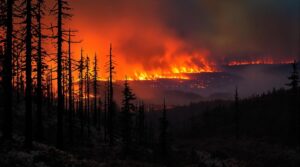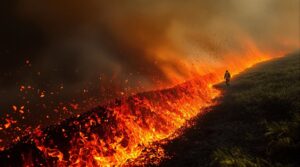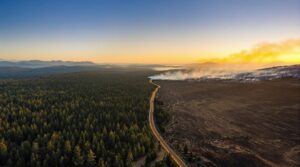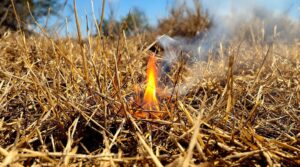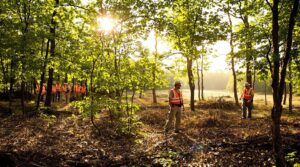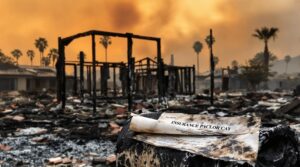Preventing wildfires requires systematic implementation of proven safety measures. Key strategies include creating defensible spaces around structures, practicing safe campfire management, and proper disposal of smoking materials. Equipment maintenance, careful fireworks handling, and community involvement strengthen prevention efforts. Early warning systems and vegetation management reduce risks, while prompt reporting of suspicious activities aids containment. These fundamental practices form the foundation for thorough wildfire prevention, with each measure building upon established safety protocols. Additionally, educating communities about effective wildfire prevention strategies and techniques is essential for fostering a culture of safety and vigilance. Local workshops and outreach programs can empower residents to take proactive steps in safeguarding their surroundings. By promoting collaboration among neighbors, we can enhance collective awareness and preparedness, ultimately leading to a more resilient approach to wildfire management.
Key Takeaways
- Create defensible spaces by removing flammable vegetation within 30 feet of buildings and maintaining grass below 4 inches high.
- Never leave campfires unattended and always extinguish them completely with water and dirt before departing.
- Install proper spark arrestors on machinery and avoid parking vehicles on dry grass to prevent accidental ignition.
- Monitor weather conditions regularly, especially humidity levels below 30%, and stay informed about local fire danger ratings.
- Dispose of smoking materials in designated containers and never discard cigarettes on the ground in fire-prone areas.
Create a Defensible Space Around Your Property
To effectively prevent wildfires from threatening residential structures, property owners must establish a defensible space extending at least 30 feet from their homes. This buffer zone requires the removal of flammable vegetation and regular maintenance of grass height to considerably reduce available fuel sources for potential fires.
Implementation of National Fire Protection Association (NFPA) zone guidelines is essential, focusing on maintaining adequate spacing between trees and shrubs to prevent flame transmission.
Property owners should incorporate fire-resistant plants and landscaping materials within the defensible space to minimize ignition risks during high-heat conditions. Regular pruning of trees is necessary to eliminate dead branches and create vertical clearance, ensuring no branches extend within 10 feet of the roof.
To prevent wildfires from gaining momentum, homeowners must consistently clear dead leaves, pine needles, and debris from gutters, roofs, and around the foundation, thereby eliminating additional fuel sources that could compromise the property's safety.
Practice Safe Campfire Management
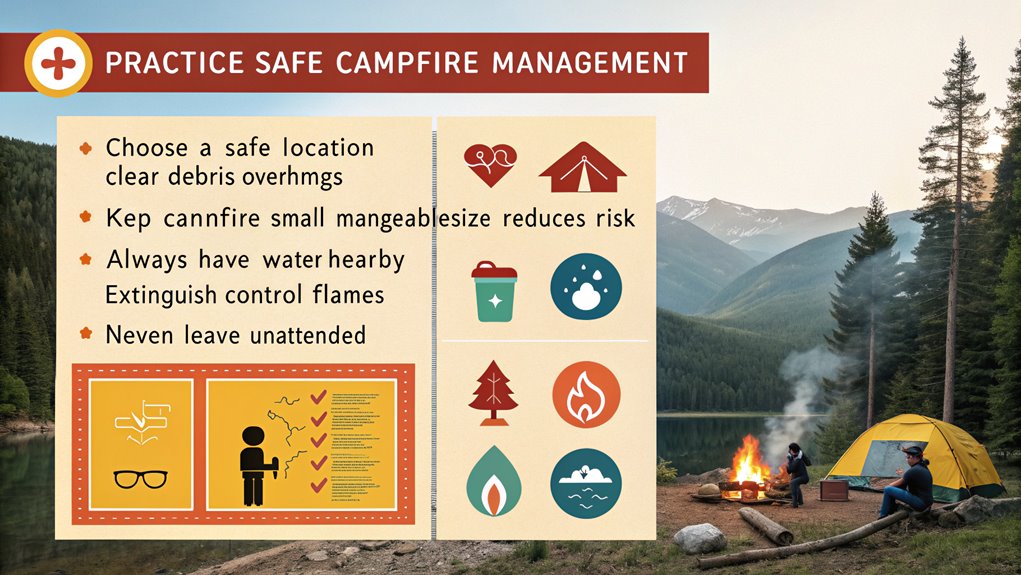
Practicing safe campfire management requires strict adherence to established guidelines and protocols that minimize wildfire risks. To prevent accidental spark fires, campers must utilize designated fire pits or rings cleared of vegetation and encircled by stones. Maintaining a 15-foot distance from tents, vehicles, and combustible materials is essential for safety.
| Safety Measure | Implementation |
|---|---|
| Location | Use designated fire pits only |
| Weather | Avoid starting fires on windy days |
| Supervision | Never leave campfires unattended |
| Extinguishment | Use water and dirt completely |
Before starting campfires, individuals must check local regulations and obtain necessary permits, as restrictions vary based on fire danger levels. Proper extinguishment involves thoroughly dousing flames with water and covering them with dirt until all embers are cold. These measures are vital in preventing the spread of wildfires from recreational campfires, which can quickly escalate into devastating forest fires under unfavorable conditions.
Properly Dispose of Smoking Materials
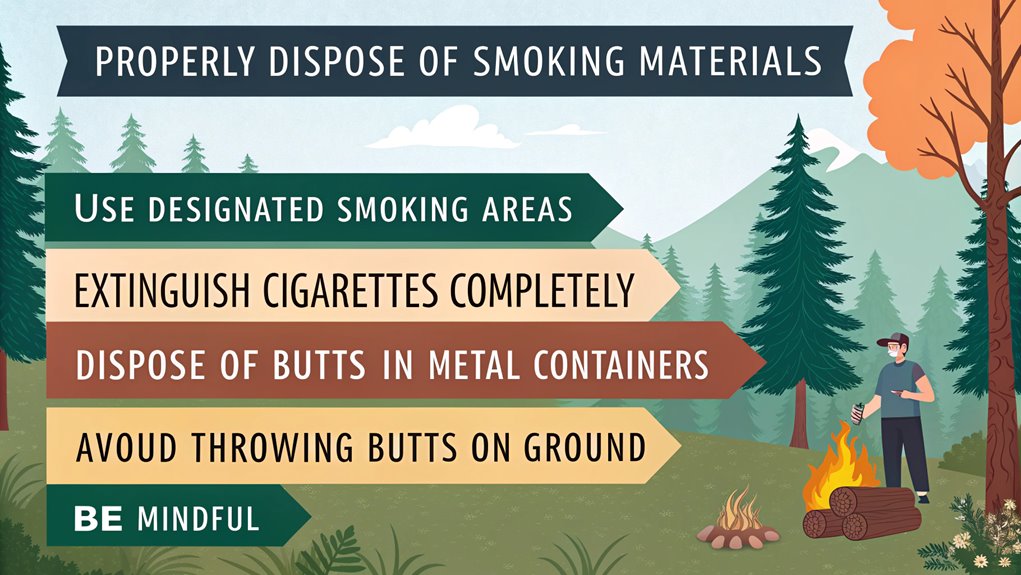
Proper disposal of smoking materials is critical for wildfire prevention, requiring smokers to extinguish cigarettes completely in designated containers or water.
Designated smoking areas provide controlled environments away from combustible vegetation and flammable materials, reducing fire risks in vulnerable locations.
Safe cigarette disposal methods include using closed metal containers, sand-filled receptacles, or proper ash trays rather than discarding materials on the ground where they can ignite dry brush and vegetation.
Safe Cigarette Disposal Methods
Safe cigarette disposal ranks among the most critical preventive measures for wildfire prevention. Proper disposal requires placing cigarette butts and matches in designated fireproof containers or water to ascertain complete extinguishment. This practice helps prevent wildfires by eliminating the risk of smoldering embers igniting surrounding vegetation.
When traveling, motorists must refrain from discarding cigarettes through vehicle windows, as this dangerous practice frequently triggers wildfires in arid regions.
Safe cigarette disposal methods include using portable ashtrays while outdoors and verifying that all smoking materials are fully extinguished before disposal.
Additionally, individuals should familiarize themselves with local smoking regulations in fire-prone areas to ascertain compliance and minimize fire risks through responsible behavior.
Designated Smoking Areas Only
While designated smoking areas serve as an essential wildfire prevention measure, their strategic placement away from dry vegetation markedly reduces fire risks in susceptible regions.
These zones, particularly critical in areas prone to wildfires in California, are specifically designed with safety features including closed containers filled with water for proper cigarette disposal and cleared surroundings devoid of flammable materials.
During periods of elevated fire danger, local authorities may implement outdoor smoking restrictions near equipment and vehicles to prevent accidental ignition.
This precautionary approach is justified, considering that improperly discarded smoking materials account for approximately 90% of human-caused wildfires.
Community education initiatives emphasize the mandatory use of these designated areas, as smoking materials that smolder in unauthorized locations can trigger devastating forest fires under suitable conditions.
Wildfire Defense Services utilize advanced monitoring systems and thermal sensors to detect potential fire risks from improperly discarded smoking materials in high-risk regions.
Maintain Equipment and Vehicles
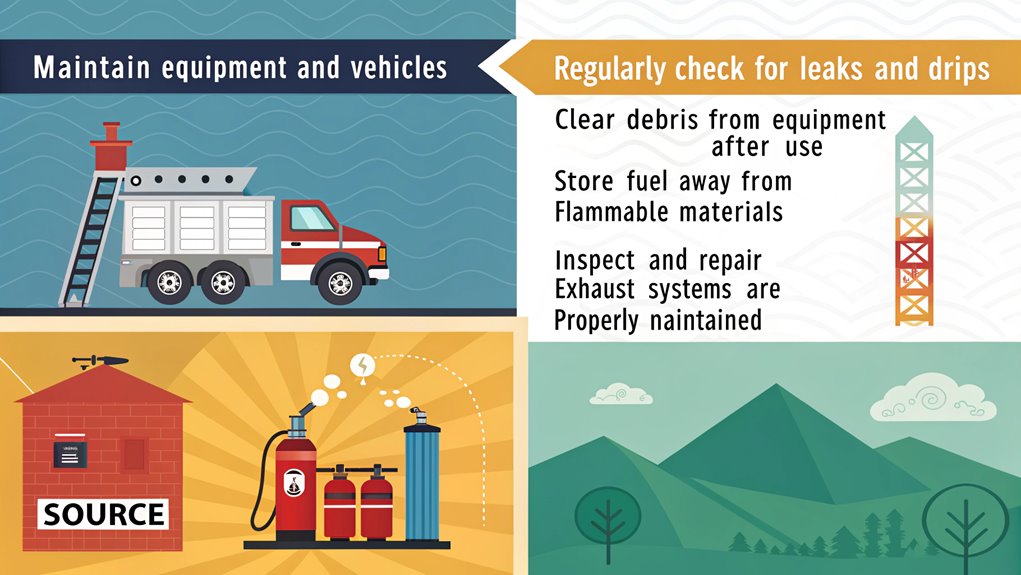
Equipment and vehicle maintenance plays a vital role in wildfire prevention. Regular equipment inspections must focus on ensuring spark arrestors are properly installed on machinery used in wooded areas.
Vehicle safety protocols should include avoiding parking on dry grass, as hot exhaust systems can ignite flammable vegetation underneath.
Machinery maintenance extends beyond mechanical functionality to include proper handling of combustible materials. Operators must immediately clean any gasoline or oil spills from tools and equipment, as these substances present considerable fire risks.
Before deploying machinery in wildland areas, thorough pre-operation checks help identify and address potential fire hazards. Additionally, all equipment and vehicles should be equipped with appropriate fire safety tools, such as fire extinguishers or shovels, enabling swift response to any ignition.
This all-encompassing approach to equipment and vehicle maintenance greatly reduces the risk of accidental wildfires caused by mechanical operations.
Handle Fireworks With Extreme Caution
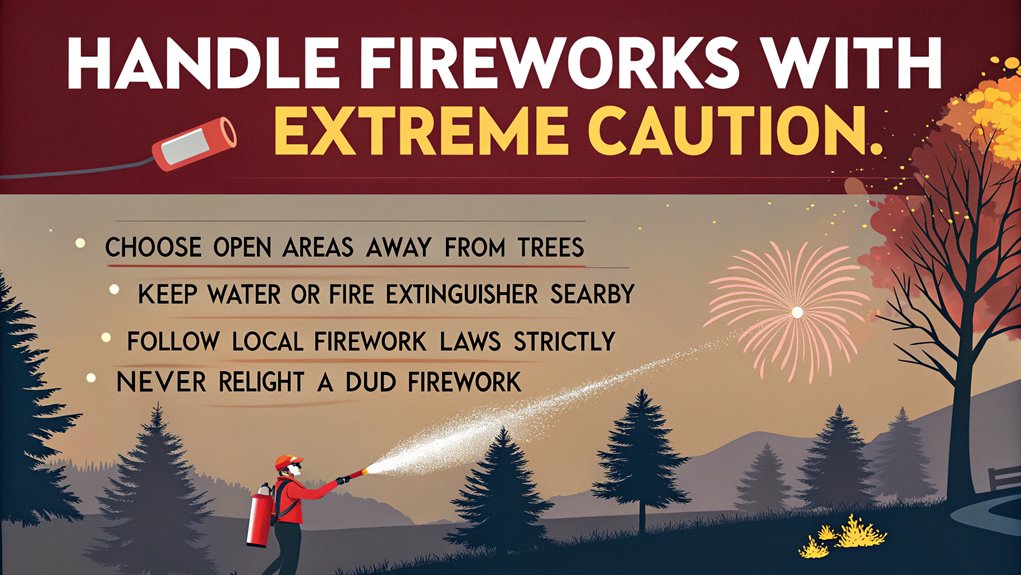
The safe handling of fireworks requires professional expertise and adherence to local fire regulations, particularly during high fire risk seasons.
Essential precautions include maintaining readily available water sources, such as hoses or fire extinguishers, to immediately address any accidental ignitions.
Professional setup and management of firework displays greatly reduce wildfire risks by ensuring proper safety protocols and equipment placement.
Property owners should verify their wildfire coverage exclusions to understand potential limitations in insurance protection during firework-related incidents.
Professional Setup Required
Since fireworks pose considerable wildfire risks, their proper handling requires strict adherence to professional safety protocols and local regulations. Professional setup guarantees compliance with firework regulations while implementing essential safety measures to prevent fire hazards. Qualified experts conduct thorough site assessments and maintain proper safety equipment throughout the display.
| Safety Element | Professional Requirements |
|---|---|
| Site Inspection | Assessment of terrain and vegetation |
| Equipment Check | Fire extinguishers and water sources |
| Weather Analysis | Wind conditions and fire risk levels |
Professional inspections must verify adequate safety distances from structures and vegetation, proper equipment positioning, and appropriate environmental conditions. Technicians typically wet surrounding areas before displays and monitor wind conditions throughout the event. They maintain direct supervision over all firework activities and guarantee immediate access to fire suppression resources, greatly reducing wildfire risks through their expertise and preparedness.
Keep Water Sources Ready
Ready access to water sources and fire suppression equipment stands as a critical requirement when handling fireworks safely. Implementing proper water storage solutions and emergency fire plans can notably reduce wildfire risks during celebrations.
Community training emphasizes the importance of maintaining multiple suppression methods nearby.
Essential preventive measures include:
- Positioning multiple water sources, hoses, and fire extinguishers within immediate reach
- Pre-wetting surrounding vegetation and grass areas before igniting any fireworks
- Establishing designated adult supervisors trained in emergency response procedures
- Thoroughly dousing used fireworks with water until completely extinguished
Wind conditions must be carefully monitored, as gusts can rapidly spread sparks beyond controlled areas.
Organizations should incorporate these safety protocols into their standard operating procedures to guarantee consistent implementation of fire prevention strategies during firework displays.
Public adjusters can provide expert guidance on developing comprehensive fire prevention and response strategies to protect property investments.
Follow Local Fire Laws
Compliance with local fire laws and ordinances remains paramount when handling fireworks to prevent wildfires. Understanding fireworks regulations and ensuring safe usage prevents devastating consequences. Areas with high fire risks often maintain strict legal consequences for violations.
| Safety Requirement | Implementation |
|---|---|
| Legal Verification | Check local ordinances before purchase |
| Weather Assessment | Avoid use during dry or windy conditions |
| Equipment Setup | Maintain water sources and extinguishers |
| Disposal Protocol | Thoroughly douse spent materials |
Safe and Sane fireworks may be permitted in certain jurisdictions, but users must verify current restrictions and safety standards. Essential precautions include wetting surrounding vegetation, maintaining proper distance from structures, and ensuring complete extinguishment of materials. During heightened fire danger periods, even typically permissible fireworks may be prohibited, making continuous awareness of local regulations essential.
Monitor Weather Conditions and Fire Alerts
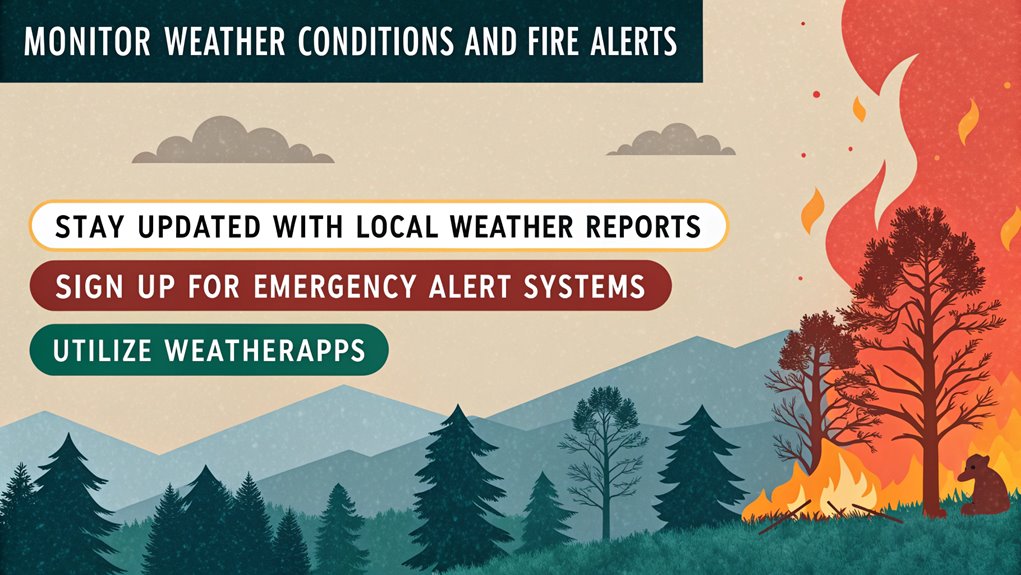
Keeping a vigilant eye on weather conditions and monitoring fire alerts represent essential steps in wildfire prevention. Weather patterns greatly influence wildfire risks, with drought conditions creating particularly dangerous scenarios. The National Weather Service's fire forecasting system helps communities prepare for potential fire hazards by issuing timely warnings when conditions become essential.
To effectively monitor fire risks, individuals should track:
- Humidity levels, particularly when they drop below 30%
- Wind speeds, especially sustained winds exceeding 15 mph
- Local burn ban notifications during dry periods
- Real-time fire alerts through mobile applications and warning systems
Understanding these environmental indicators enables communities to implement necessary precautions before conditions become hazardous. With approximately 2.6 million homes across western states facing wildfire risks, maintaining awareness of weather conditions is critical for protecting communities.
Regular monitoring of weather updates, combined with awareness of fire alerts, provides vital information for fire prevention efforts. This systematic approach to environmental awareness helps reduce the likelihood of accidental ignitions and supports rapid response when fire dangers escalate.
Join Community Prevention Programs
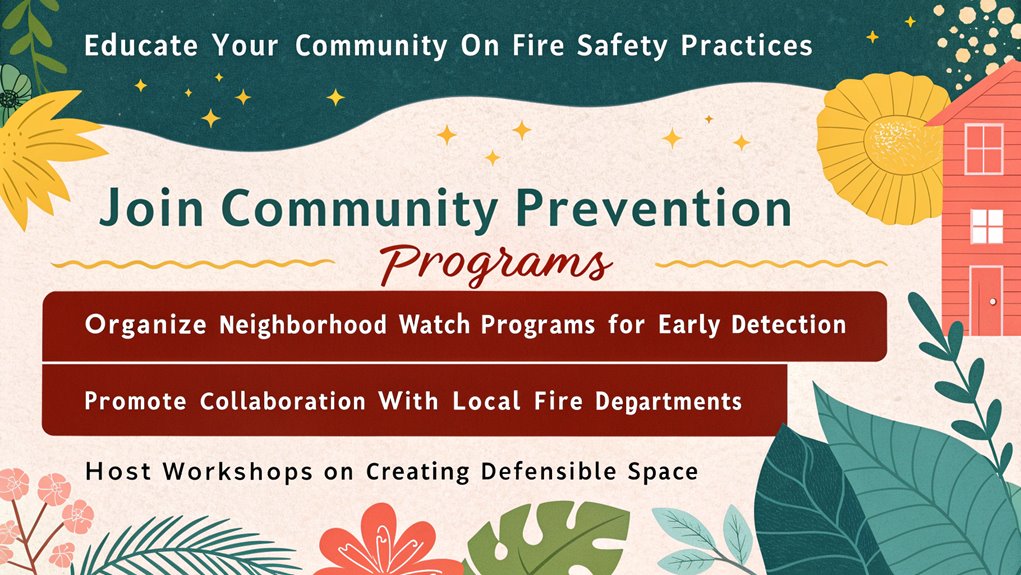
Community prevention programs offer crucial training opportunities for residents to learn proper wildfire prevention techniques and emergency response protocols.
Local neighborhood watch initiatives coordinate with fire departments to establish early warning systems and maintain communication networks during high-risk periods.
Volunteer fire prevention groups serve as essential resources for implementing defensible space strategies and conducting regular safety assessments within their communities.
Local Training Opportunities
Local fire departments across the country provide invaluable training opportunities for residents seeking to enhance their wildfire prevention knowledge. Through structured programs and hands-on workshops, community members can access local resources that build essential skills in fire safety and emergency preparedness.
These community engagement initiatives typically include:
- Defensible space creation workshops demonstrating proper vegetation management techniques
- Fire-resistant landscaping demonstrations for home protection
- Real-time hazard monitoring and reporting protocols
- Emergency response training for high-risk fire conditions
Participants often gain access to state and federal grant opportunities supporting local wildfire mitigation projects.
These training programs foster collaboration between citizens and fire authorities, strengthening neighborhood watch networks and improving overall community resilience against wildfire threats.
The thorough education provided guarantees residents are well-equipped to implement effective prevention strategies.
Neighborhood Watch Programs
Vigilance plays an essential role in effective wildfire prevention through organized Neighborhood Watch programs. These community engagement strategies enable residents to monitor their surroundings and implement proactive fire prevention measures.
Through collaboration with local fire departments, participants receive specialized training in identifying potential fire hazards and maintaining safe outdoor practices.
Regular fire safety workshops and neighborhood communication tools facilitate the exchange of critical information among community members. This coordinated approach leads to the establishment of defensible spaces in residential areas and strengthens the community's preparedness for wildfire emergencies.
The program's structure guarantees efficient evacuation procedures and rapid dissemination of alerts when needed.
Volunteer Fire Prevention Groups
Active participation in volunteer fire prevention groups represents an essential component of robust wildfire management strategies. Through organized community outreach initiatives and fire safety workshops, these programs enable citizens to contribute meaningfully to local fire prevention efforts.
Volunteer recruitment strategies focus on building teams capable of implementing extensive protection measures.
Key activities conducted by volunteer groups include:
- Organizing defensible space workshops to teach proper vegetation management
- Maintaining recreational trails and parks to reduce potential fuel sources
- Establishing monitoring systems for early fire hazard detection
- Creating firebreaks and conducting regular safety assessments
These collaborative efforts connect participants with valuable resources and training opportunities while fostering community engagement in wildfire prevention.
The systematic approach guarantees sustained implementation of preventive measures across fire-prone areas.
Install Early Warning Detection Systems
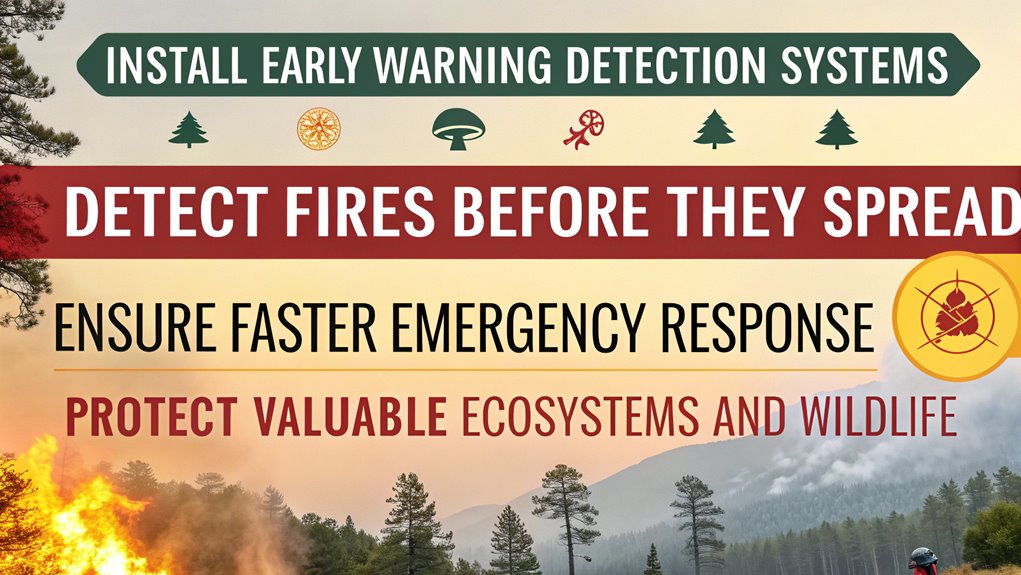
Modern early warning detection systems represent a critical advancement in wildfire prevention technology. Systems like Silvanet utilize solar-powered sensors for thorough wildfire risk assessment through continuous monitoring of microclimate conditions.
Sensor technology integration enables the detection of temperature fluctuations and humidity levels that indicate potential fire activity before visible flames emerge. Strategic placement of these sensors in high-risk areas facilitates real-time data collection, which artificial intelligence algorithms analyze to identify fire-related anomalies.
This sophisticated monitoring approach enables rapid response from firefighting teams, greatly improving containment success rates. The implementation of community alert systems keeps residents informed about developing fire risks, promoting proactive safety measures.
These technological solutions deliver significant cost benefits by reducing the need for extensive firefighting operations and post-fire restoration. The combination of early detection capabilities and automated monitoring has proven essential for enhancing wildfire prevention and management strategies.
Clear Flammable Vegetation and Debris
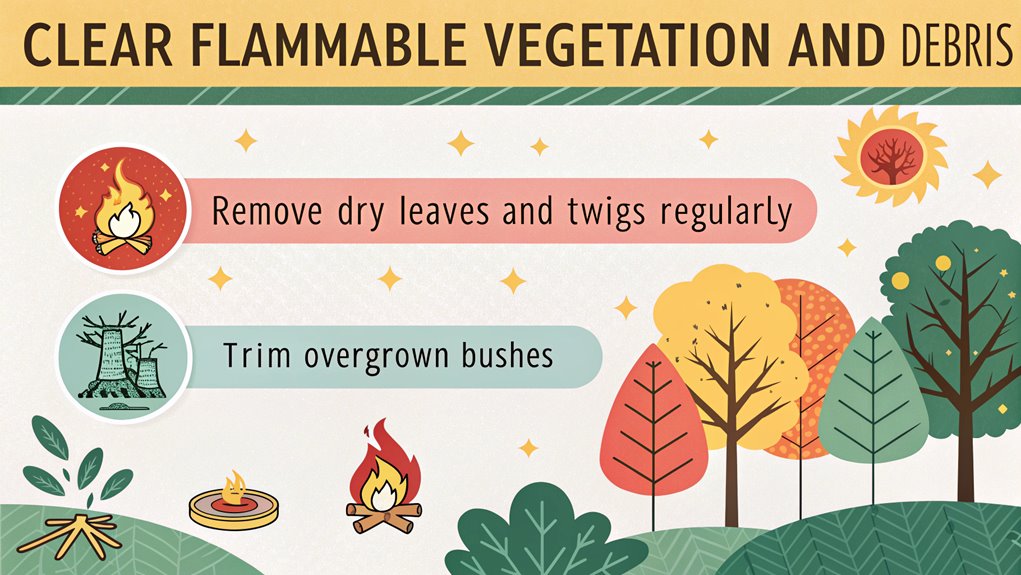
Creating effective defensible zones through systematic vegetation management serves as a fundamental wildfire prevention strategy. Proper vegetation removal techniques and regular flammable material inspection considerably reduce fire risks around residential structures. The National Fire Protection Association emphasizes maintaining a minimum 30-foot defensible perimeter through effective landscaping strategies.
Essential maintenance procedures include:
- Trimming grass to a maximum height of 4 inches to prevent ground-level fire propagation.
- Removing dense shrub corridors that can channel flames toward structures.
- Clearing gutters and roofs of combustible debris, including fallen leaves and pine needles.
- Eliminating dead vegetation, branches, and other flammable materials from the designated safety zone.
These preventive measures create barriers that impede fire progression and protect buildings from ember ignition.
Regular implementation of these practices, combined with routine property assessments, establishes a thorough defense system against potential wildfire threats.
Report Suspicious Fire Activity

Prompt reporting of suspicious fire activity plays a vital role in wildfire prevention, with nearly 90% of U.S. wildfires attributed to human causes.
Community vigilance initiatives encourage residents to monitor and report unusual smoke patterns, unexplained flames, or suspicious behavior in remote areas using designated fire reporting technology and local hotlines.
Fire prevention authorities emphasize the implementation of arson awareness training programs to educate community members about recognizing potential wildfire threats.
These programs establish protocols for documenting and reporting concerning activities while maintaining clear communication channels with local fire departments and law enforcement agencies.
Residents are instructed to utilize specialized reporting apps and emergency hotlines that enable rapid response from firefighting teams.
Effective wildfire prevention relies on coordinated community efforts, where informed citizens work collaboratively with authorities to identify and report potential fire hazards before they escalate into devastating wildfires.
Frequently Asked Questions
How Can Most Fires Be Prevented?
With humans causing 90% of wildfires, prevention requires strict adherence to fire safety protocols, responsible camping practices, and compliance with local burn regulations during high-risk conditions.
What Are 90% of Wildfires Started By?
Approximately 90% of wildfires are caused by human activities, while the remaining 10% result from natural causes like lightning strikes. Human-caused ignitions include equipment use, campfires, and negligent behavior.
How Can Kids Prevent Forest Fires?
Studies show youth education reduces fire incidents by 60%. Kids prevent forest fires through thorough fire safety training, outdoor education programs, and active community involvement in environmental protection initiatives.
How Can We Protect Wildlife From Wildfires?
Wildlife protection requires establishing wildlife corridors, creating fire-resistant habitats through strategic vegetation management, and fostering community awareness about habitat preservation techniques and emergency response protocols during wildfire events.
Final Thoughts
While wildfires can devastate vast landscapes within hours, proper prevention measures implemented over time can greatly reduce their occurrence. Advanced detection systems and community vigilance stand in contrast to the primitive forces they combat. Through systematic implementation of these evidence-based strategies, from creating defensible spaces to maintaining equipment protocols, communities can effectively minimize fire risks while preserving natural ecosystems.
For homeowners who experience property damage from wildfires, insurance industry professionals and legal experts strongly recommend consulting a qualified state-licensed public adjuster to handle insurance claims. Public adjusters work exclusively as policyholder advocates, not for insurance companies. These state-licensed professionals help policyholders navigate complex insurance policies, identify hidden damages often unknown to policyholders, document losses comprehensively, and negotiate with insurance companies to ensure fair settlements while protecting policyholder rights.
A public adjuster's expertise can lead to maximized claim payouts, faster claim processing, and reduced stress during the claims process, allowing homeowners to focus on recovery. Policyholders seeking expert assistance with property damage or loss claims can request a no-obligation free consultation with a Public Claims Adjusters Network (PCAN) member public adjuster through publicclaimsadjusters.io/contact-us/.
